经济学原理第15章
曼昆经济学原理(微观经济学分册)(第6版)课后复习题详细讲解(第15章 垄 断)
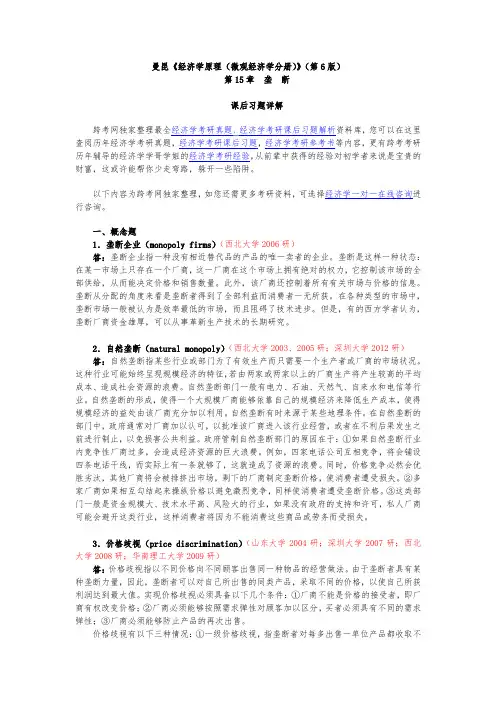
曼昆《经济学原理(微观经济学分册)》(第6版)第15章垄断课后习题详解跨考网独家整理最全经济学考研真题,经济学考研课后习题解析资料库,您可以在这里查阅历年经济学考研真题,经济学考研课后习题,经济学考研参考书等内容,更有跨考考研历年辅导的经济学学哥学姐的经济学考研经验,从前辈中获得的经验对初学者来说是宝贵的财富,这或许能帮你少走弯路,躲开一些陷阱。
以下内容为跨考网独家整理,如您还需更多考研资料,可选择经济学一对一在线咨询进行咨询。
一、概念题1.垄断企业(monopoly firms)(西北大学2006研)答:垄断企业指一种没有相近替代品的产品的唯一卖者的企业。
垄断是这样一种状态:在某一市场上只存在一个厂商,这一厂商在这个市场上拥有绝对的权力,它控制该市场的全部供给,从而能决定价格和销售数量。
此外,该厂商还控制着所有有关市场与价格的信息。
垄断从分配的角度来看是垄断者得到了全部利益而消费者一无所获。
在各种类型的市场中,垄断市场一般被认为是效率最低的市场,而且阻碍了技术进步。
但是,有的西方学者认为,垄断厂商资金雄厚,可以从事革新生产技术的长期研究。
2.自然垄断(natural monopoly)(西北大学2003、2005研;深圳大学2012研)答:自然垄断指某些行业或部门为了有效生产而只需要一个生产者或厂商的市场状况。
这种行业可能始终呈现规模经济的特征,若由两家或两家以上的厂商生产将产生较高的平均成本、造成社会资源的浪费。
自然垄断部门一般有电力、石油、天然气、自来水和电信等行业。
自然垄断的形成,使得一个大规模厂商能够依靠自己的规模经济来降低生产成本,使得规模经济的益处由该厂商充分加以利用。
自然垄断有时来源于某些地理条件。
在自然垄断的部门中,政府通常对厂商加以认可,以批准该厂商进入该行业经营,或者在不利后果发生之前进行制止,以免损害公共利益。
政府管制自然垄断部门的原因在于:①如果自然垄断行业内竞争性厂商过多,会造成经济资源的巨大浪费。
曼昆《经济学原理(微观经济学分册)》第6版课后习题详解(1~2章)
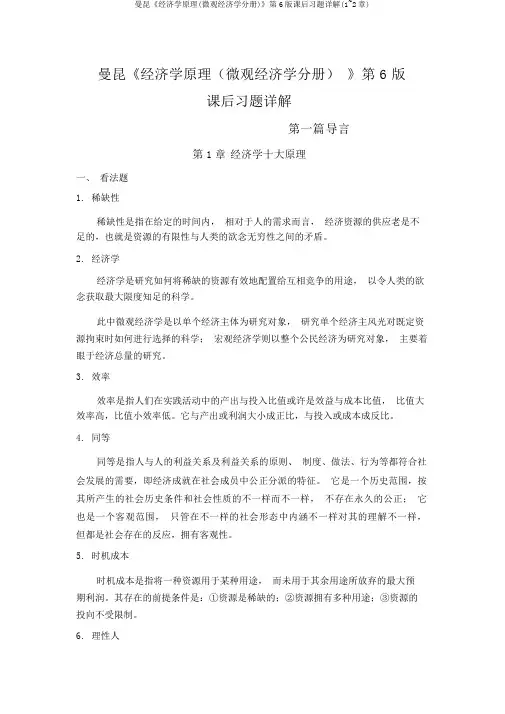
曼昆《经济学原理(微观经济学分册)》第 6 版课后习题详解第一篇导言第1章经济学十大原理一、看法题1.稀缺性稀缺性是指在给定的时间内,相对于人的需求而言,经济资源的供应老是不足的,也就是资源的有限性与人类的欲念无穷性之间的矛盾。
2.经济学经济学是研究如何将稀缺的资源有效地配置给互相竞争的用途,以令人类的欲念获取最大限度知足的科学。
此中微观经济学是以单个经济主体为研究对象,研究单个经济主风光对既定资源拘束时如何进行选择的科学;宏观经济学则以整个公民经济为研究对象,主要着眼于经济总量的研究。
3.效率效率是指人们在实践活动中的产出与投入比值或许是效益与成本比值,比值大效率高,比值小效率低。
它与产出或利润大小成正比,与投入或成本成反比。
4.同等同等是指人与人的利益关系及利益关系的原则、制度、做法、行为等都符合社会发展的需要,即经济成就在社会成员中公正分派的特征。
它是一个历史范围,按其所产生的社会历史条件和社会性质的不一样而不一样,不存在永久的公正;它也是一个客观范围,只管在不一样的社会形态中内涵不一样对其的理解不一样,但都是社会存在的反应,拥有客观性。
5.时机成本时机成本是指将一种资源用于某种用途,而未用于其余用途所放弃的最大预期利润。
其存在的前提条件是:①资源是稀缺的;②资源拥有多种用途;③资源的投向不受限制。
6.理性人理性人是指系统而有目的地尽最大努力去实现其目标的人,是经济研究中所假定的、在必定条件下拥有典型理性行为的经济活动主体。
7.边沿改动边沿改动是指对行动计划的细小增量调整。
8.激励激励是指惹起一个人做出某种行为的某种东西。
9.市场经济市场经济是指由家庭和公司在市场上的互相交易决定资源配置的经济,而资源配置本质上就是决定社会生产什么、生产多少、如何生产以及为谁生产的过程。
10.产权产权是指个人拥有并控制稀缺资源的能力,也能够理解为人们对其所交易东西的所有权,即人们在交易活动中使自己或别人在经济利益上得益或受损的权利。
第15章 垄断 曼昆经济学原理第七版
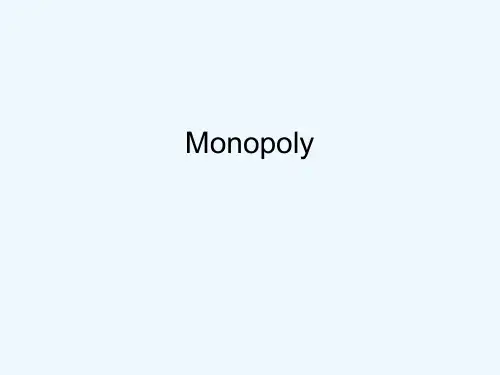
Figure 2
Demand Curves for Competitive and Monopoly Firms
(a) A Competitive Firm’s Demand Curve
(b) A Monopolist’s Demand Curve
Price
Price
Demand
Demand
0
Quantity of output
© 2015 Cengage Learning. All Rights Reserved. May not be copied, scanned, or duplicated, in whole or in part, except for use as
10
permitted in a license distributed with a certain product or service or otherwise on a password-protected website for classroom use.
– A high price reduces the quantity purchased
– Outcome: often not the best for society
Why Monopolies Arise
• Governments
– Can sometimes improve market outcome
• Increase in quantity sold
– Output effect
• Q is higher: increase total revenue
– Price effect
• P is lower: decrease total revenue
(NEW)曼昆《经济学原理(微观经济学分册)》(第6版)课后习题详解
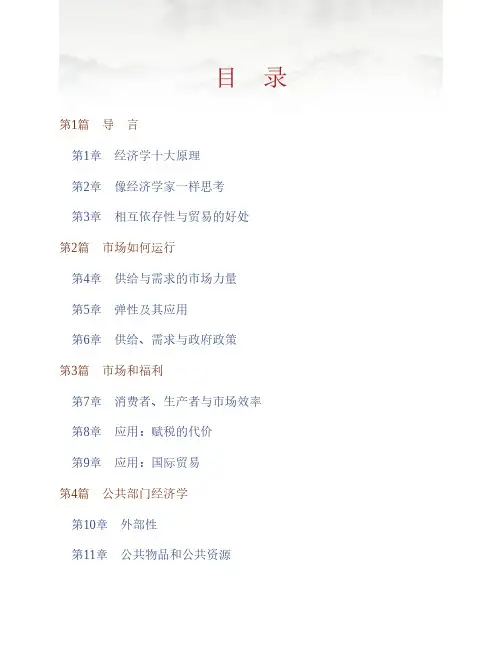
目 录第1篇 导 言第1章 经济学十大原理第2章 像经济学家一样思考第3章 相互依存性与贸易的好处第2篇 市场如何运行第4章 供给与需求的市场力量第5章 弹性及其应用第6章 供给、需求与政府政策第3篇 市场和福利第7章 消费者、生产者与市场效率第8章 应用:赋税的代价第9章 应用:国际贸易第4篇 公共部门经济学第10章 外部性第11章 公共物品和公共资源第12章 税制的设计第5篇 企业行为与产业组织第13章 生产成本第14章 竞争市场上的企业第15章 垄 断第16章 垄断竞争第17章 寡 头第6篇 劳动市场经济学第18章 生产要素市场第19章 收入与歧视第20章 收入不平等与贫困第7篇 深入研究的论题第21章 消费者选择理论第22章 微观经济学前沿第1篇 导 言第1章 经济学十大原理一、概念题1.稀缺性(scarcity)答:经济学研究的问题和经济物品都是以稀缺性为前提的。
稀缺性指在给定的时间内,相对于人的需求而言,经济资源的供给总是不足的,也就是资源的有用性与有限性。
人类消费各种物品的欲望是无限的,满足这种欲望的物品,有的可以不付出任何代价而随意取得,称之为自由物品,如阳光和空气;但绝大多数物品是不能自由取用的,因为世界上的资源(包括物质资源和人力资源)是有限的,这种有限的、为获取它必须付出某种代价的物品,称为“经济物品”。
正因为稀缺性的客观存在,地球上就存在着资源的有限性和人类的欲望与需求的无限性之间的矛盾。
经济学的一个重要研究任务就是:“研究人们如何进行抉择,以便使用稀缺的或有限的生产性资源(土地、劳动、资本品如机器、技术知识)来生产各种商品,并把它们分配给不同的社会成员进行消费。
”也就是从经济学角度来研究使用有限的资源来生产什么、如何生产和为谁生产的问题。
2.经济学(economics)答:经济学是研究如何将稀缺的资源有效地配置给相互竞争的用途,以使人类的欲望得到最大限度满足的科学。
时下经常见诸国内报刊文献的“现代西方经济学”一词,大多也都在这个意义上使用。
曼昆经济学原理英文版文案加习题答案15章
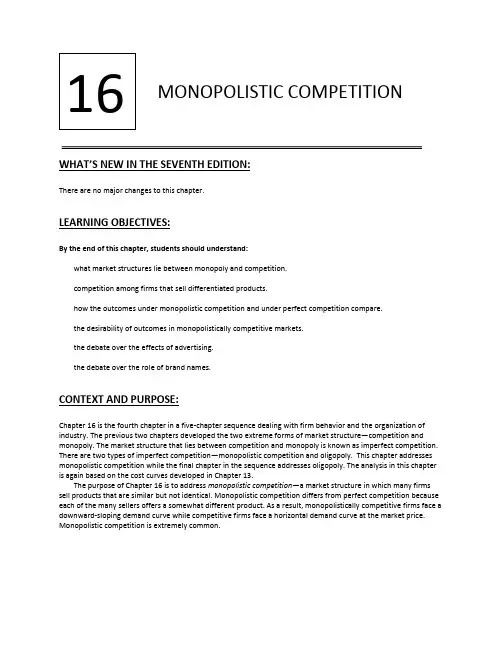
MONOPOLISTIC COMPETITIONWHAT’S NEW IN THE S EVENTH EDITION:There are no major changes to this chapter.LEARNING OBJECTIVES:By the end of this chapter, students should understand:what market structures lie between monopoly and competition.competition among firms that sell differentiated products.how the outcomes under monopolistic competition and under perfect competition compare.the desirability of outcomes in monopolistically competitive markets.the debate over the effects of advertising.the debate over the role of brand names.CONTEXT AND PURPOSE:Chapter 16 is the fourth chapter in a five-chapter sequence dealing with firm behavior and the organization of industry. The previous two chapters developed the two extreme forms of market structure—competition and monopoly. The market structure that lies between competition and monopoly is known as imperfect competition. There are two types of imperfect competition—monopolistic competition and oligopoly. This chapter addresses monopolistic competition while the final chapter in the sequence addresses oligopoly. The analysis in this chapter is again based on the cost curves developed in Chapter 13.The purpose of Chapter 16 is to address monopolistic competition—a market structure in which many firms sell products that are similar but not identical. Monopolistic competition differs from perfect competition because each of the many sellers offers a somewhat different product. As a result, monopolistically competitive firms face a downward-sloping demand curve while competitive firms face a horizontal demand curve at the market price. Monopolistic competition is extremely common.KEY POINTS:A monopolistically competitive market is characterized by three attributes: many firms, differentiatedproducts, and free entry.The long-run equilibrium in a monopolistically competitive market differs from that in a perfectly competitive market in two related ways. First, each firm in a monopolistically competitive market has excess capacity. That is, it chooses a quantity that puts it on the downward-sloping portion of the average-total-cost curve. Second, each firm charges a price above marginal cost.Monopolistic competition does not have all of the desirable properties of perfect competition. There is the standard deadweight loss of monopoly caused by the markup of price over marginal cost. In addition, the number of firms (and thus the variety of products) can be too large or too small. In practice, the ability of policymakers to correct these inefficiencies is limited.The product differentiation inherent in monopolistic competition leads to the use of advertising and brand names. Critics of advertising and brand names argue that firms use them to manipulate consumers’ tastes and to reduce competition. Defenders of advertising and brand names argue that firms use them to informconsumers and to compete more vigorously on price and product quality.CHAPTER OUTLINE:I. Between Monopoly and Perfect CompetitionA. The typical firm has some market power, but its market power is not as great as that described bymonopoly.B. Firms in imperfect competition lie somewhere between the competitive model and the monopoly model.C. Definition of oligopoly: a market structure in which only a few sellers offer similar or identical products.1. Economists measure a market’s domination by a small number of firms with a statistic called aconcentration ratio.2. The concentration ratio is the percentage of total output in the market supplied by the four largestfirms.3. In the . economy, most industries have a four-firm concentration ratio under 50%.D. Definition of monopolistic competition: a market structure in which many firms sell products that aresimilar but not identical.1. Characteristics of Monopolistic Competitiona. Many Sellersb. Product Differentiationc. Free EntryE. Figure 1 summarizes the four types of market structure. Note that it is the number of firms and the typeof product sold that distinguishes one market structure from another.II. Competition with Differentiated ProductsA. The Monopolistically Competitive Firm in the Short Run1. Each firm in monopolistic competition faces a downward-sloping demand curve because its product isdifferent from those offered by other firms.2. The monopolistically competitive firm follows a monopolist's rule for maximizing profit.a. It chooses the output level where marginal revenue is equal to marginal cost.b. It sets the price using the demand curve to ensure that consumers will demand exactly theamount produced.Figure 23. We can determine whether or not the monopolistically competitive firm is earning a profit or loss bycomparing price and average total cost.a. If P > ATC, the firm is earning a profit.b. If P < ATC, the firm is earning a loss.c. If P = ATC, the firm is earning zero economic profit.B. The Long-Run Equilibrium1. When firms in monopolistic competition are making profit, new firms have an incentive to enter themarket.a. This increases the number of products from which consumers can choose.b. Thus, the demand curve faced by each firm shifts to the left.c. As the demand falls, these firms experience declining profit.2. When firms in monopolistic competition are incurring losses, firms in the market will have anincentive to exit.a. Consumers will have fewer products from which to choose.b. Thus, the demand curve for each firm shifts to the right.c. The losses of the remaining firms will fall.3. The process of exit and entry continues until the firms in the market are earning zero profit.a. This means that the demand curve and the average-total-cost curve are tangent to each other.b. At this point, price is equal to average total cost and the firm is earning zero economic profit. Figure 3Remember that students have a hard time understanding why a firm will continue tooperate if it is earning “only” zero economic profit. Remind them that zero economic profitmeans that firms are earning an accounting profit equal to their implicit costs.Point out to students that, just like firms in perfect competition, firms in monopolisticcompetition also earn zero economic profit in the long run. Show them that this result occursbecause firms can freely enter the market when profits occur, driving the level of profits tozero. Any market with no barriers to entry will see zero economic profit in the long run.4. There are two characteristics that describe the long-run equilibrium in a monopolistically competitivemarket.a. Price exceeds marginal cost (due to the fact that each firm faces a downward-sloping demandcurve).b. Price equals average total cost (due to the freedom of entry and exit).C. Monopolistic versus Perfect CompetitionFigure 41. Excess Capacitya. The quantity of output produced by a monopolistically competitive firm is smaller than thequantity that minimizes average total cost (the efficient scale).b. This implies that firms in monopolistic competition have excess capacity, because the firm couldincrease its output and lower its average total cost of production.c. Because firms in perfect competition produce where price is equal to the minimum average totalcost, firms in perfect competition produce at their efficient scale.2. Markup over Marginal Costa. In monopolistic competition, price is greater than marginal cost because the firm has somemarket power.b. In perfect competition, price is equal to marginal cost.D. Monopolistic Competition and the Welfare of Society1. One source of inefficiency is the markup over marginal cost. This implies a deadweight loss (similar tothat caused by monopolies).2. Because there are so many firms in this type of market structure, regulating these firms would bedifficult.3. Also, forcing these firms to set price equal to marginal cost would force them out of business(because they are already earning zero economic profit).4. There are also externalities associated with entry.a. The product-variety externality occurs because as new firms enter, consumers get someconsumer surplus from the introduction of a new product. Note that this is a positive externality.b. The business-stealing externality occurs because as new firms enter, other firms lose customersand profit. Note that this is a negative externality.c. Depending on which externality is larger, a monopolistically competitive market could have toofew or too many products.5. In the News: Insufficient Variety as a Market Failurea. Firms may insufficiently service consumers with unusual preferences in markets with large fixedcostsb. This article from Slate describes how some consumers get left out of the market because of thehigh fixed costs associated with creating additional varieties of a product.III. AdvertisingA. The Debate over Advertising1. The Critique of Advertisinga. Firms advertise to manipulate people's tastes.b. Advertising impedes competition because it increases the perception of product differentiationand fosters brand loyalty. This means that consumers will be less concerned with pricedifferences among similar goods.2. The Defense of Advertisinga. Firms use advertising to provide information to consumers.b. Advertising fosters competition because it allows consumers to be better informed about all ofthe firms in the market.3. Case Study: Advertising and the Price of Eyeglassesa. In the United States during the 1960s, states differed on whether or not they allowed advertisingfor optometrists.b. In the states that prohibited advertising, the average price paid for a pair of eyeglasses in 1963was $33; in states that allowed advertising, the average price was $26 (a difference of more than20%).B. Advertising as a Signal of Quality1. The willingness of a firm to spend a large amount of money on advertising may be a signal toconsumers about the quality of the product being offered.2. Example: Kellogg and Post have each developed a new cereal that would sell for $3 per box. (Assumethat the marginal cost of producing the cereal is zero.) Each company knows that if it spends $10million on advertising, it will get one million new consumers to try the product. If consumers like the product, they will buy it again.a. Post has discovered through market research that its new cereal is not very good. After buying itonce, consumers would not likely buy it again. Thus, it will only earn $3 million in revenue, whichwould not be enough to pay for the advertising. Therefore, it does not advertise.b. Kellogg knows that its cereal is great. Each person that buys it will likely buy one box per monthfor the next year. Therefore, its sales would be $36 million, which is more than enough to justifythe advertisement.c. By its willingness to spend money on advertising, Kellogg signals to consumers the quality of itscereal.3. Note that the content of the advertisement is unimportant; what is important is that consumersknow that the advertisements are expensive.C. Brand Names1. In many markets there are two types of firms; some firms sell products with widely recognized brandnames while others sell generic substitutes.2. Critics of brand names argue that they cause consumers to perceive differences that do not reallyexist.3. Economists have defended brand names as a useful way to ensure that goods are of high quality.a. Brand names provide consumers with information about quality when quality cannot be judgedeasily in advance of purchase.b. Brand names give firms an incentive to maintain high quality, because firms have a financialstake in maintaining the reputation of their brand names.SOLUTIONS TO TEXT PROBLEMS:Quick Quizzes1. Oligopoly is a market structure in which only a few sellers offer similar or identical products.Examples include the market for breakfast cereals and the world market for crude oil. Monopolisticcompetition is a market structure in which many firms sell products that are similar but not identical.Examples include the markets for novels, movies, restaurant meals, and computer games.2. The three key attributes of monopolistic competition are: (1) there are many sellers; (2) each firmproduces a slightly different product; and (3) firms can enter or exit the market freely.Figure 1 shows the long-run equilibrium in a monopolistically competitive market. This equilibriumdiffers from that in a perfectly competitive market because price exceeds marginal cost and the firmdoes not produce at the minimum point of average total cost but instead produces at less than theefficient scale.Figure 13. Advertising may make markets les s competitive if it manipulates people’s tastes rather than beinginformative. Advertising may give consumers the perception that there is a greater differencebetween two products than really exists. That makes the demand curve for a product more inelastic,so the firms can then charge greater markups over marginal cost. However, some advertising couldmake markets more competitive because it sometimes provides useful information to consumers,allowing them to take advantage of price differences more easily. Advertising also facilitates entrybecause it can be used to inform consumers about a new product. In addition, expensive advertisingcan be a signal of quality.Brand names may be beneficial because they provide information to consumers about the quality ofgoods. They also give firms an incentive to maintain high quality, since their reputations areimportant. But brand names may be criticized because they may simply differentiate products thatare not really different, as in the case of drugs that are identical with the brand-name drug selling at amuch higher price than the generic drug.Questions for Review1. The three attributes of monopolistic competition are: (1) there are many sellers; (2) each sellerproduces a slightly different product; and (3) firms can enter or exit the market without restriction.Monopolistic competition is like monopoly because firms face a downward-sloping demand curve, soprice exceeds marginal cost. Monopolistic competition is like perfect competition because, in the longrun, price equals average total cost, as free entry and exit drive economic profit to zero.2. In Figure 2, a firm has demand curve D1 and marginal-revenue curve MR1. The firm is making profitsbecause at quantity Q1, price (P1) is above average total cost (ATC). Those profits induce other firmsto enter the industry, causing the demand curve to shift to D2 and the marginal-revenue curve to shiftto MR2. The result is a decline in quantity to Q2, at which point the price (P2) equals average total cost (ATC), so profits are now zero.Figure 23. Figure 3 shows the long-run equilibrium in a monopolistically competitive market. Price equalsaverage total cost. Price is above marginal cost.Figure 34. Because, in equilibrium, price is above marginal cost, a monopolistic competitor produces too littleoutput. But this is a hard problem to solve because: (1) the administrative burden of regulating the large number of monopolistically competitive firms would be high; and (2) the firms are earning zero economic profits, so forcing them to price at marginal cost means that firms would lose money unless the government subsidized them.5. Advertising might reduce economic well-being because it manipulates people's tastes and impedescompetition by making products appear more different than they really are. But advertising might increase economic well-being by providing useful information to consumers and fosteringcompetition.6. Advertising with no apparent informational content might convey information to consumers if itprovides a signal of quality. A firm will not be willing to spend much money advertising a low-qualitygood, but may be willing to spend significantly more to advertise a high-quality good.7. The two benefits that might arise from the existence of brand names are: (1) brand names provideconsumers information about quality when quality cannot be easily judged in advance; and (2) brandnames give firms an incentive to maintain high quality to maintain the reputation of their brandnames.Quick Check Multiple Choice1. b2. d3. a4. d5. a6. cProblems and Applications1. a. Tap water is a monopoly because there is a single seller of tap water to a household .b. Bottled water is a monopolistically competitive market. There are many sellers of bottled water,but each firm tries to differentiate its own brand from the rest.c. The cola market is an oligopoly. There are only a few firms that control a large portion of themarket.d. The beer market is an oligopoly. There are only a few firms that control a large portion of themarket.2. a. The market for wooden #2 pencils is perfectly competitive because pencils by any manufacturerare identical and there are a large number of manufacturers.b. The market for copper is perfectly competitive, because all copper is identical and there are alarge number of producers.c. The market for local electricity service is monopolistic because it is a natural monopoly—it ischeaper for one firm to supply all the output.d. The market for peanut butter is monopolistically competitive because different brand namesexist with different quality characteristics.e. The market for lipstick is monopolistically competitive because lipstick from different firmsdiffers slightly, but there are a large number of firms that can enter or exit without restriction.3. a. A firm in monopolistic competition sells a differentiated product from its competitors.b. A firm in monopolistic competition has marginal revenue less than price.c. Neither a firm in monopolistic competition nor in perfect competition earns economic profit inthe long run.d. A firm in perfect competition produces at the minimum average total cost in the long run.e. Both a firm in monopolistic competition and a firm in perfect competition equate marginalrevenue and marginal cost.f. A firm in monopolistic competition charges a price above marginal cost.4. a. Both a firm in monopolistic competition and a monopoly firm face a downward-sloping demandcurve.b. Both a firm in monopolistic competition and a monopoly firm have marginal revenue that is lessthan price.c. A firm in monopolistic competition faces the entry of new firms selling similar products.d. A monopoly firm earns economic profit in the long run.e. Both a firm in monopolistic competition and a monopoly firm equate marginal revenue andmarginal cost.f. Neither a firm in monopolistic competition nor a monopoly firm produces the socially efficientquantity of output.5. a. The firm is not maximizing profit. For a firm in monopolistic competition, price is greater thanmarginal revenue. If price is below marginal cost, marginal revenue must be less than marginalcost. Thus, the firm should reduce its output to increase its profit.b. The firm may be maximizing profit if marginal revenue is equal to marginal cost. However, thefirm is not in long-run equilibrium because price is less than average total cost. In this case, firms will exit the industry and the demand facing the remaining firms will rise until economic profit is zero.c. The firm is not maximizing profit. For a firm in monopolistic competition, price is greater thanmarginal revenue. If price is equal to marginal cost, marginal revenue must be less than marginal cost. Thus, the firm should reduce its output to increase its profit.d. The firm could be maximizing profit if marginal revenue is equal to marginal cost. The firm is inlong-run equilibrium because price is equal to average total cost. Therefore, the firm is earningzero economic profit.6. a. Figure 4 illustrates the market for Sparkle toothpaste in long-run equilibrium. The profit-maximizing level of output is Q M and the price is P M.Figure 4b. Sparkle's profit is zero, because at quantity Q M, price equals average total cost.c. The consumer surplus from the purchase of Sparkle toothpaste is areas A + B. The efficient levelof output occurs where the demand curve intersects the marginal-cost curve, at Q C. Thedeadweight loss is area C, the area above marginal cost and below demand, from Q M to Q C.d. If the government forced Sparkle to produce the efficient level of output, the firm would losemoney because average total cost would exceed price, so the firm would shut down. If thathappened, Sparkle's customers would earn no consumer surplus.7. a. As N rises, the demand for each firm’s product falls. As a result, each firm’s demand curve willshift left.b. The firm will produce where MR = MC:100/N– 2Q = 2QQ = 25/Nc. 25/N = 100/N–PP = 75/Nd. Total revenue = P Q = 75/N 25/N = 1875/N2Total cost = 50 + Q2 = 50 + (25/N)2 = 50 + 625/N2Profit = 1875/N2– 625/N2– 50 = 1250/N2– 50e. In the long run, profit will be zero. Thus:1250/N2– 50 = 01250/N2 = 50N = 58. Figure 5 shows the cost, marginal revenue and demand curves for the firm under both conditions.Figure 5a. The price will fall from P MC to the minimum average total cost (P C) when the market becomesperfectly competitive.b. The quantity produced by a typical firm will rise to Q C, which is at the efficient scale of output.c. Average total cost will fall as the firm increases its output to the efficient scale.d. Marginal cost will rise as output rises. Marginal cost is now equal to price.e. Profit will not change. In either case, the market will move to long-run equilibrium where allfirms will earn zero economic profit.9. a. A family-owned restaurant would be more likely to advertise than a family-owned farm becausethe output of the farm is sold in a perfectly competitive market, in which there is no reason toadvertise, while the output of the restaurant is sold in a monopolistically competitive market.b. A manufacturer of cars is more likely to advertise than a manufacturer of forklifts because thereis little difference between different brands of industrial products like forklifts, while there aregreater perceived differences between consumer products like cars. The possible return toadvertising is greater in the case of cars than in the case of forklifts.c. A company that invented a very comfortable razor is likely to advertise more than a companythat invented a less comfortable razor that costs the same amount to make because thecompany with the very comfortable razor will get many repeat sales over time to cover the cost of the advertising, while the company with the less comfortable razor will not.10. a. Figure 6 shows Sleek’s demand, marginal-revenue, marginal-cost, and average-total-cost curves.The firm will maximize profit at an output level of Q * and a price of P *. The shaded are shows the firm’s profits.Figure 6b. In the long run, firms will enter, shifting the demand for Sleek’s product to the left. Its price andoutput will fall. Firms will enter until profits are equal to zero (as shown in Figure 7).Figure 7c. As consumers become more focused on the stylistic differences in brands, they will be lessfocused on price. This will make the demand for each firm’s products more price inelastic. The demand curves may become relatively steeper, allowing Sleek to charge a higher price. If these stylistic features cannot be copied, they may serve as a barrier to entry and allow Sleek to earn profit in the long run.d. A firm in monopolistic competition produces where marginal revenue is greater than zero. Thismeans that firm must be operating on the elastic portion of its demand curve.。
曼昆《经济学原理(微观经济学分册)》(第6版)笔记和课后习题(含考研真题)详解-第15章 垄 断【圣
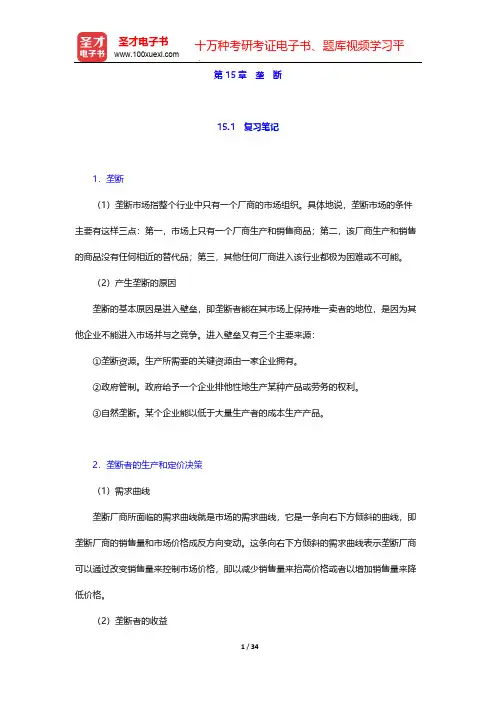
价格。
(3)利润最大化
垄断厂商为了获得最大的利润,也必须遵循 MR MC 的原则。
在垄断市场上,价格大于边际成本。因而,对于垄断企业有: P MR MC
在垄断企业选择了使边际收益等于边际成本的产量之后,就可以用需求曲线找出与那
种产量对应的价格。
(4)垄断利润
利润等于总收益( TR )减去总成本( TC )
圣才电子书
十万种考研考证电子书、题库视频学习平 台
第 15 章 垄 断
15.1 复习笔记
1.垄断 (1)垄断市场指整个行业中只有一个厂商的市场组织。具体地说,垄断市场的条件 主要有这样三点:第一,市场上只有一个厂商生产和销售商品;第二,该厂商生产和销售 的商品没有任何相近的替代品;第三,其他任何厂商进入该行业都极为困难或不可能。 (2)产生垄断的原因 垄断的基本原因是进入壁垒,即垄断者能在其市场上保持唯一卖者的地位,是因为其 他企业不能进入市场并与之竞争。进入壁垒又有三个主要来源: ①垄断资源。生产所需要的关键资源由一家企业拥有。 ②政府管制。政府给予一个企业排他性地生产某种产品或劳务的权利。 ③自然垄断。某个企业能以低于大量生产者的成本生产产品。
1 / 34
圣才电子书
十万种考研考证电子)曲线也是向右下方倾斜的,且位于平均收益( AR )曲线
的下方,这表示在每一个销售量上厂商的边际收益都小于平均收益。之所以出现 MR AR ,
是因为只要平均量下降,边际量就总是小于平均量。
如 15-3(b)所示,每位对物品评价大于边际成本的顾客都买到了物品,并支付了其支付
意愿的价格。所有互惠的贸易都进行了,没有无谓损失,垄断生产者得到了以利润形式表
示的市场的全部剩余。
图 15-3 有无价格歧视时的福利
曼昆经济学原理11章--15章课后答案
第十一章公共物品和共有资源复习题1.解释一种物品有“排他性”的含义。
解释一种物品有“竞争性”的含义。
比萨饼有排他性吗?有竞争性吗?答:一种物品具有“排他性”是指可以阻止一个人使用一种物品时该物品的特性。
一种物品有竞争性是指一个人使用一种物品减少其他人使用该物品的特性。
比萨饼有排他性,只要不卖给某人比萨饼就可以阻止他使用。
比萨饼也有竞争性,一个人多吃一块比萨饼,会使其他人少享受一块。
2.给公共物品下定义并举出一个例子。
私人市场本身能提供这种物品吗?并解释之。
答:公共物品是既无排他性又无竞争性的物品,私人市场本身不能提供这种物品。
公共物品没有排他性,因此,无法对公共物品的使用者收费,在私人提供这种物品时就存在搭便车的激励,从而使私人提供者无利可图。
3.什么是公共物品的成本一收益分析?为什么它是重要的?进行这种分析困难吗?答:公共物品的成本一收益分析是提供一种公共物品的社会成本和社会收益比较的研究。
只有比较提供一种公共物品的成本与收益,政府才能决定是否值得提供这种公共物品。
公共物品的成本一收益分析是一项艰苦的工作。
因为所有的人都可以免费使用一种公共物品,没有判断这种公共物品价值的价格。
简单地问人们,他们对一种公共物品的评价是多少是不可靠的。
那些受益于该公共物品的人有夸大他们的利益的激励。
那些受害于该公共物品的人有夸大他们成本的激励。
4.给共有资源下定义并举出一个例子。
没有政府干预,人们使用这种物品会太多还是太少?为什么?答:共有资源是有竞争性但无排他性的物品。
没有政府干预,人们使用这种物品会太多。
因为不能向使用共有资源的人收费,而且,一个人对共有资源的使用会减少其他人的使用,所以,共有资源往往被过度使用。
问题与应用1.本书认为公共物品和共有资源都涉及外部性。
A.与公共物品相关的外部性一般是正的还是负的?用例子来回答。
自由市场的公共物品量一般是大于还是小于有效率的数量?答:与公共物品相关的外部性一般是负的。
曼昆《经济学原理(微观经济学分册)》(第6版)课后习题详解
第14章竞争市场上 的企业
第13章生产成本
第15章垄断
第16章垄断 竞争
第17章寡头
第19章收入与歧视
第18章生产要素市 场
第20章收入不平等 与贫困
第21章消费 者选择理论
第22章微观 经济学前沿
作者介绍
读书笔记
这是《曼昆《经济学原理(微观经济学分册)》(第6版)课后习题详解》的读书笔记模板,可以替换为自己 的心得。
目录分析
第2章像经济学家 一样思考
第1章经济学十大 原理
第3章相互依存性 与贸易的好处
第5章弹性及其应 用
第4章供给与需求 的市场力量
第6章供给、需求 与政府政策
第8章应用:赋税 的代价
第7章消费者、生 产者与市场效率
第9章应用:国际 贸易
第11章公共物品和 公共资源
第10章外部性
第12章税制的设计
曼昆《经济学原理(微观经济学分 册)》(第6版)课后习题详解
读书笔记模板
01 思维导图
03 目录分析 05 读书笔记
目录
02 内容摘要 04 作者介绍 06 精彩摘录
思维导图
关键字分析思维导图
习题
教材
消费者
微观经济 学
企业
习题
供给
微观经 济学
经济学
原理
第章
需求
曼昆经济 学பைடு நூலகம்
市场
经济学家
第篇
收入
应用
税制
内容摘要
本书特别适用于参加研究生入学考试指定考研参考书目为曼昆《经济学原理(微观经济学分册)》的考生, 也可供各大院校学习曼昆《经济学原理(微观经济学分册)》的师生参考。曼昆的《经济学原理》是世界上最流 行的初级经济学教材,也被众多院校列为经济类专业考研重要参考书目。为了帮助学生更好地学习这本教材,我 们有针对性地编著了它的配套辅导用书(均提供免费下载,免费升级):1.曼昆《经济学原理(微观经济学分 册)》(第6版)笔记和课后习题详解(含考研真题)[视频讲解]2.曼昆《经济学原理(微观经济学分册)》 【教材精讲+考研真题解析】讲义与视频课程【35小时高清视频】3.曼昆《经济学原理(微观经济学分册)》 (第6版)课后习题详解4.曼昆《经济学原理(微观经济学分册)》(第5版)课后习题详解5.曼昆《经济学原 理(微观经济学分册)》配套题库【名校考研真题(视频讲解)+课后习题+章节练习+模拟试题】6.曼昆《经济 学原理(宏观经济学分册)》(第6版)笔记和课后习题详解(含考研真题)[视频讲解]7.曼昆《经济学原理 (宏观经济学分册)》【教材精讲+考研真题解析】讲义与视频课程【27小时高清视频】8.曼昆《经济学原理 (宏观经济学分册)》(第6版)课后习题详解9.曼昆《经济学原理(宏观经济学分册)》(第5版)课后习题 详解10.曼昆《经济学原理(宏观经济学分册)》配套题库【名校考研真题(视频讲解)+课后习题+章节练习+ 模拟试题】本书是曼昆《经济学原理(微观经济学分册)》(第6版)教材的配套e书,参考国外教材的英文答案 和相关资料对曼昆《经济学原理(微观经济学分册)》(第6版)教材每章的课后习题进行了详细的分析和解答, 并对个别知识点进行了扩展。课后习题答案久经修改,非常标准,特别适合应试作答和临考冲刺。另外,部分高 校,如武汉大学、深圳大学等,研究生入学考试部分真题就来自于该书课后习题,因此建议考生多加重视。
经济学原理知识点总结
经济学原理名词解释第一章1.稀缺性:社会拥有的资源是有限的;因此不能生产人们希望用油的所有物品与劳务2.经济学:研究社会如何管理自己的稀缺资源3.效率:社会能从稀缺资源中得到的最大利益4.平等:讲这些资源的成果平均地分配给社会成员5.机会成本:为了得到这种东西所放弃的东西6.理性人:能系统而由母的的尽最大努力去实现目标7.编辑变动:对现有行动计划的微小增量调整8.激励:引起一个人做出某种行为的某种东西9.市场失灵:市场本身不能有效配置资源的情况10.外部性:一个人的行为对旁观者福利的影响11.市场势力:单个人或者一小群人不适当地影响市场价格的能力12.生产率:每一单位劳动投入所生产的物品与劳动数量经济学十大原理1、人们面临权衡取舍2、某种东西的成本是为了得到它所放弃的东西3、理性人考虑边际量4、人们会对激励做出反应5、毛衣可以使每个人的状况都变得更好6、市场通常是组织经济活动的一种好方法7、政府又是可以改善市场结果8、一国的生活水平取决于它生产物品与劳务的能力9、当政府发行了过多的货币时;物价上升10、社会面临通货膨胀与事业之间的短期权衡取舍第二章要点1.循环流向图;见书20..在这个模型中;经济由两类觉得这;家庭和企业组成;2.物品与劳务市场上;家庭是买者;生产要素市场上;家庭是卖者3.生产可能性边界:一个图形;标明在生产要素和生产技术既定时;一个经济所能生产的产出..大炮与黄油4.微观经济学:研究家庭和企业如何做出决策;以及他们如何在特定市场上相互影响5.宏观经济学:研究整体经济现象6.关于世界的表述有两种类型:一;实证表述:描述性的;关于世界是什么样子的表述;二;规范表述:关于世界应该是什么样子的表述第四章供给与需求的市场力量1.某种物品与劳务的买者与卖者组成的一个群体2、竞争市场:有许多买者与卖者;以至于一个人对市场价格的影响微乎其微的市场3、完全竞争的市场具有的两个特征:可供销售的物品是完全相同的;买者与卖者众多以至于任何一个买者或卖者无法影响市场价格;此时他们被称为价格接受者4、垄断者:一些市场只有一个卖者;由他决定价格5.需求量:买者愿意并且能够购买的该种物品的数量6.需求定理:在其他条件不变的情况下;价格上升;该物品的需求量减少;价格下降;需求量增加7.需求曲线:把价格与需求量联系一起的向右下方倾斜的曲线8.市场需求:所有个人对某种特定物品或劳务的需求的总和9.需求变动:需求曲线向右移动为去求增加;向左移动为需求减少10.影响需求量的因素:价格11.影响需求的因素:收入;相关物品的价格;嗜好;预期;买者数量12.供给量:卖者愿意并且能够出售的该种物品的数量13.供给定理:在其他条件不变时;一种物品价格上升;该物品的供给量增加;一种物品价格下降;该物品供给量减少14.供给变动:供给曲线向右移动;为供给增加;供给曲线向左移动;为供给减少15.影响供给的因素:投入品的价格;技术;预期;卖者数量16.分析均衡变动的三个步骤:一;确定该事件是使供给曲线移动还是使需求曲线移动;还是两者都移动;二;确定曲线移动方向;三..用供求图说明这种移动如何改变均衡价格和均衡数量分析实例:66—6917.在市场经济中;价格是引导经济决策;从而配置稀缺资源的信号..对于经济中的每一种物品来说;价格确保供给与需求达到平衡;因此;均衡价格决定了买者选择购买多少这种物品;以及买者选择生产多少这种物品第五章弹性及其应用1.需求价格弹性:衡量需求量对价格变动的反应程度;如果需求量对价格变动的反应很大;就说这种物品的需求是富有弹性的;反之~~~~2.决定需求价格弹性的一般规律:一;相近替代品的可获得性:有相近替代品的物品的需求往往比较富有弹性二;必需品与奢侈品:必需品的需求往往缺乏弹性;而奢侈品的需求往往富有弹性三;市场定义:任何一个市场上的需求弹性都取决于我们所划定的市场范围..范围小的市场的需求弹性往往大于范围大的市场的需求弹性;因为范围小的市场上的物品更容易找到相近的替代品..比如冰激凌是一个较狭义的范畴;它的需求富有弹性;因为容易找到其他甜点代替..三;时间框架:物品的需求往往在长期内更富有弹性..3.需求价格弹性=需求量变动百分比÷价格变动百分比4.中点法计算两点间需求价格弹性:77页5.各种需求曲线:6.总收益与需求价格弹性:如果需求是缺乏弹性的;价格上升将引起总收益增加;如果需求富有弹性;价格上升引起总收益减少..图79一般规律:一:当需求缺乏弹性;价格弹性小于1;价格和总收益同方向变动二:当需求富有弹性;价格弹性大于1;价格和总收益反方向变动三:如果需求是单位弹性;价格弹性为1;价格变动;总收益不变..其他需求弹性1.需求收入弹性:衡量消费者收入变动时需求量如何变动..公式:需求收入弹性:需求量变动百分比÷收入变动百分比2.需求的交叉价格弹性:衡量一种物品需求量对于另一种武林价格变动的反应程度公式:需求的交叉价格弹性=物品1的需求量变动百分比÷物品2的价格变动百分比p.s.替代品的交叉价格弹性是整数;互补品的交叉价格弹性是负数供给弹性1.供给价格弹性:衡量供给量对价格变动的反应程度2.公式:供给价格弹性=供给量变动百分比÷价格变动百分比3.各种供给曲线4.供求工具的运动;见书85----89第六章供给;需求与政府政策1.价格上下限:法定最高低价格2.价格上限:一:均衡价格低于上限;价格上限是非限制性的二:均衡价格高于上限;价格上限对市场有一种限制性约束..当政府对竞争市场实行限制性价格上限;就产生了物品的短缺;而且卖者必须在大量潜在的买者中配给稀缺物品..3.价格下限:一:均衡价格高于下限;价格下限是非限制性的二:均衡价格低于下限;价格下限是限制性的;限制性价格下限引起了过剩4.劳动供给与劳动需求平衡的市场;限制性最低工资高于均衡工资;引起过剩;劳动供给量大于需求量;结果是出现失业..见书97页5.税收总是由买者与卖者共同分摊..税收一直了市场活动..见书101页6.弹性与税收归宿:税收负担更多地落在缺乏弹性的市场一方身上..图示见书104第七章消费者;生产者与市场效率1.支付意愿:每一个买者愿意支付的最高价格2.消费者剩余:买者愿意为一种物品支付的量减去其为此实际支付的量3.用需求曲线衡量消费者剩余:需求曲线以下;和价格以上的面积衡量一个市场上的消费者剩余..图示见书114---1154.生产者剩余:卖者得到的量减去其生产成本..生产者剩余衡量卖者参与市场中得到的利益..5.用攻击曲线衡量生产者剩余:价格之下攻击曲线以上的面积衡量一个市场上的生产者剩余..图示见书1186.总剩余=买者的评价—卖者的成本7.如果资源配置使总剩余最大化;我们说;这种高配置表现出效率..如果一种物品不是由成本最低的卖者生产的;配置就是无效率的..8.除了效率之外;社会计划者还应该关心平等;即市场上的各个买者与卖者是否有相似的经济福利水平..9.三个市场结果的观点一:自由市场把物品的攻击分配给对这些物品评价最高的买者;这种评价用买者的支付意愿衡量二:自由市场将物品的需求分配给能够以最低成本生产这些物品的卖者三:自由市场生产处使消费者剩余和生产者剩余的总和最大化的物品量..10.为了使总剩余最大化;社会计划者应该选择攻击曲线与需求曲线相交时的产量..图示见书120—121第十章外部性1.外部性:当一个人从事一种影响旁观者福利;而对这种影响不付报酬又得不到报酬的活动时;就产生了外部性..外部性的内在化:得到了报酬或者支付了报酬2.正负外部性:对旁观者的影响有利不利..3.总之;负外部性使市场生产的数量大于社会合意的数量;正外部性使市场生产的数量小于社会合意的数量..为了解决这个问题;政府可以通过对有负外部性的物品征税并给予有正外部性的物品补贴来使外部性内在化..4.针对外部性的公共政策:一,命令与控制政策直接对行为进行管制二,以市场为基础的政策提供激励;以促使私人决策者自己来解决问题矫正税改变了激励;使其考虑到外部性的存在;从而使资源配置向社会最适水平移动..因此;矫正税既增加了政府的收入;又提高了经济效率..案例分析详见168—1715.科斯定理:在吗某些情况下;私人市场在解决外部性方面非常有效..6.根据科斯定理;如果私人各方可以无成本地就资源配置进行协商;那么;私人市场就总能解决外部性问题;并有效地配置资源..7.科斯定理说明;死人经济主体可以解决他们之间的外部性问题..无论最初的权利如何分配;有关各方总可以达成一种协议;在这种协议中;每个人的状况都刻意变好;而且结果是有效率的..8.交易成本:各方在达成协议及遵守协议过程中所发生的成本..9.许多情况下;在许多利益各方间达成协议是很困难的;从而科斯定理并不适用..第十一章1.私人物品:在消费中既有排他性又有竞争性2.公共物品:在消费中既无排他性又无竞争性3.公共资源:在消费中有竞争性但没排他性4.自然垄断的物品:在消费中有排他性但无竞争性5.搭便车者:得到一种物品的利益但避开为此付费的人6.一些重要的公共物品:国防;基础研究即一般性知识无专利;反贫困7.一些重要的公共资源:清洁的水和空气;拥挤的道路;一些野生动物..8.公地悲剧的理解第15章一国收入的衡量名词解释:1、国内生产总值GDP:在某一既定诗琪一个国家内生产的最终物品与劳务的市场价值2、国民生产总值GNP:一国永久居民称为国民;;其所赚到的总收入..与国内生产总值不同之处在于;它包括本国公民在国外赚到的收入;而不包括外国人在本国赚到的收入..3、国民生产净值NNP:是一国居民总收入GNP减折旧..折旧是经济中设备和建筑物存量的磨损或损耗..4、国民收入:一国居民在物品与劳务生产中赚到的总收入..与国民生产净值不同之处在于;它不包括间接的企业税;但包括企业补贴;两者不同还源于由数据收集问题引起的统计误差..5、个人收入:家庭和非公司制企业得到的收入..6、个人可支配收入:家庭和非公司制企业在完成它们对政府的义务后剩下的收入..7、GDPY的组成;消费C;投资I;政府购买G;净出口NXY=C+I+G+NX8、消费:是家庭除购买新住房之外用于物品和劳务的支出..物品包括家庭购买的汽车与家电等耐用品以及食品和衣服等非耐用品;劳务包括理发医疗等无形的东西;也包括教育..9、投资:是用于对未来生产更多物品和劳务的物品的购买;它是资本设备;存货;建筑物购买的总和..包括新住房支出..10、政府购买:包括地方;州;和联邦政府用于物品与劳务的支出..包括政府员工的薪水和用于公务的支出..11、净出口:等于外国对国内生产的物品的购买出口减国内对外国物品的购买出口..12、名义GDP:按现期价格评价的物品与劳务的生产13、真实GDP:按不变价格评价的物品与劳务的生产;计算真实GDP时首先指定一年作为基年..14、GDP平减指数=名义GDP/真实GDP100衡量的是相对于基年价格的现期物价水平;反应了价格的变动..15、通货膨胀率:从一个时期到下一个时期某个物价水平衡量指标变动的百分比..如果用GDP平减指数两个相连年份的通货膨胀率用如下方法计算;第二年的GDP平减指数-第一年的GDP平减指数/第一年的GDP平减指数100%第16章生活费用的衡量1、消费物价指数CPI:普通消费者所购买的物品与劳务总费用的衡量标准..2、消费物价指数的计算:(1)固定篮子:固定种类的物品及对应的数量(2)找出价格:找出每个时点上篮子中每种物品与劳务的价格(3)计算这一篮子东西的费用:用价格数据计算不同时期一篮子物品与劳务的费用..(4)选择基年并计算指数:消费物价指数=当年一篮子物品与劳务的价格/基年一篮子物品与劳务的价格100%(5)计算通货膨胀率第二年CPI-第一年CPI/第一年CPI100%3、生产物价指数PPI:衡量企业而不是消费者购买的一篮子物品与劳务的费用4、两个重要差别使GDP平减指数与CPI不一致(1)GDP平减指数反映国内生产的所有物品与劳务的价格;而消费物价指数反映消费者购买的所有物品与劳务的价格..(2)更微妙的差别设计如何对各种价格进行加权以得出一个物价总水平的数字..消费物价水平指数比较的是固定的一个篮子物品与劳务的价格与基年这一篮子物品与劳务的价格;而这一篮子物品的构成不经常变动..GDP平减指数比较的是现期生产的物品和劳务的价格与基年同样物品和劳务的价格..因此用来计算GDP平减指数的物品与劳务的组合自动地随时间的推移而变动..如果所有价格变动的比例不同;对于各种价格加权的方法对于整个通货膨胀率就是至关重要的..P279页5、今天美元的数量=T年美元的数量今天的物价水平/T年的物价水平6、通货膨胀的指数化:根据法律或合同自动地按物价水平的变动校正的美元量7、名义利率和真实利率:名义利率:衡量美元数量变动的利率真实利率:根据通货膨胀校正的利率真实利率=名义利率-通货膨胀利率第17章生产与增长1、生产率的决定因素:(1)人均物质资本:用于生产物品与劳务的设备和建筑物存量称为物质资本..(2)人均人力资本:人力资本是经济学家用来指工人通过教育、培训和经验而获得的知识与技能的一个术语..人力资本包括在早期儿童教育、小学、中学、大学和成人劳动力在职培训中所积累的技能..(3)人均自然资源:自然资源是自然界提供的生产投入;如土地;河流;矿藏..有可再生和不可再生两种形式..(4)技术知识:对生产物品和劳务的最好方法的了解..2、收益递减:随着资本存量的增加;由增加的一单位资本生产的额外产量减少..3、追赶效应:资本的收益递减还有一层更重要的意义;在其他条件相同的情况下;如果一国开始时比较穷;它就更容易实现迅速增长..4、经济增长和公共政策:P297-305了解第20章失业1、就业者:这类人包括作为得到报酬的员工而工作的人;在自己的企业里工作且得到报酬的人;以及在家族企业里工作但拿不到报酬的人..2、失业者:这类人包括能够工作且在之前十周内努力找工作但没有找到工作的人;还包括被解雇正在等待重新被找回工作岗位的人..3、非劳动力:这类人包括不属于前两类的人;如全日制的学生;家务劳动者和退休人员..4、劳动力:就业者与失业者之和..5、失业率:失业者占劳动力的百分比..6、劳动力参工率:总成年人口中劳动力所占百分比7、摩擦性失业:公认寻找最适合自己的工作需要时间;由使工人与工作相匹配的过程所引起的失业有时称为摩擦性失业..通常认为这种失业可以解释较短的失业持续时间..8、结构性失业:在某些劳动市场上课提供的工作岗位数量可能不足以为每个想工作的人提供工作..当劳动的供给量大于需要量时就出现了这种情况;出现这种类型的失业;通常认为这种失业可以解释较长的失业持续时间..正如我们将要看到的;当工资由于某些原因高于使供求均衡的水平时;就产生了这种失业..9、工会:是一个就工资、津贴和工作条件与雇主进行谈判的工人协会..工会是一种卡特尔垄断组织..10、工会与企业就就业条件达成一致的过程称为集体谈判..11、罢工:如果工会和企业没有达成协议;工会就会组织工人从企业撤出劳动..12、三种使工资高于均衡水平的原因:最低工资发、工会、效率工资P345-35513、几种效率工资理论:工人健康、工人流动率、工人素质、工人努力程度第21章货币制度1、货币:是经济中人们经常用于相互购买物品与劳务的一组资产..在经济中有三种职能:交换媒介;计价单位;价值储藏手段2、货币的种类:(1)商品货币:货币采取有内在价值的商品形式;如黄金(2)法定货币:没有内在价值的货币..3、流动性:用来说明一种资产兑换为经济中的交换媒介的容易程度..4、货币存量:经济中流通的货币量..5、通货:公众受众的纸币钞票和铸币..6、活期存款:储户可以简单地通过开支票而随时支取的银行账户余额..。
曼昆《经济学原理微观经济学分册》第版笔记第章垄断
曼昆《经济学原理(微观经济学分册)》(第版)笔记(第章--垄--断)————————————————————————————————作者:————————————————————————————————日期:曼昆《经济学原理(微观经济学分册)》(第6版)第15章垄断复习笔记跨考网独家整理最全经济学考研真题,经济学考研课后习题解析资料库,您可以在这里查阅历年经济学考研真题,经济学考研课后习题,经济学考研参考书等内容,更有跨考考研历年辅导的经济学学哥学姐的经济学考研经验,从前辈中获得的经验对初学者来说是宝贵的财富,这或许能帮你少走弯路,躲开一些陷阱。
以下内容为跨考网独家整理,如您还需更多考研资料,可选择经济学一对一在线咨询进行咨询。
一、垄断产生的原因垄断企业是指一个没有相似替代品的产品的唯一卖者的企业。
垄断产生的基本原因是进入壁垒:垄断企业能在其市场上保持唯一卖者的地位,是因为其他企业不能进入市场并与之竞争。
进入壁垒有三个主要形成原因:第一,垄断资源:生产所需要的关键资源由单个企业所拥有;第二,政府管制:政府给予单个企业排他性地生产某种物品或劳务的权利;第三,生产流程:某个企业能以低于大量生产者的成本生产产品。
1.垄断资源垄断产生的最简单方法是单个企业拥有一种关键的资源。
垄断企业比竞争市场上任何一家企业有大得多的市场势力。
即使产品边际成本很低,垄断企业也可以利用市场势力也可以制定极高的价格。
虽然关键资源的排他性所有权是垄断的一个潜在起因,但实际上垄断很少产生于这种原因。
现实经济如此巨大,且资源由许多人拥有。
由于许多物品可以在国际上交易,它们的市场的自然范围往往很广泛。
因此,拥有没有相近替代品资源的企业的例子很少。
2.创造的垄断在许多情况下,垄断的产生是因为政府给予一个人或一个企业排他性地出售某种物品或劳务的权利,有时垄断产生于想成为垄断者的人的政治影响,还有些时候,政府也会出于公共利益而赋予某种垄断的权利。
- 1、下载文档前请自行甄别文档内容的完整性,平台不提供额外的编辑、内容补充、找答案等附加服务。
- 2、"仅部分预览"的文档,不可在线预览部分如存在完整性等问题,可反馈申请退款(可完整预览的文档不适用该条件!)。
- 3、如文档侵犯您的权益,请联系客服反馈,我们会尽快为您处理(人工客服工作时间:9:00-18:30)。
34
Q 0 1 2 3 4 5 P $4.50 4.00 3.50 3.00 2.50 2.00 TR AR MR
n.a.
6
1.50
7
主动学习 1
参考答案
这里, P = AR, 和竞 争市场一样 MR < P, 而竞争性企 业的MR = P
Q P TR AR MR $4 3 2 1 0 –1
8
0
1 2 3 4 5 6
的。 企业能够实行价格歧视,它一定具有某种市场力量。
在价格歧视中所依据的特征是支付意愿 一个企业能对有更高支付意愿的买者收取一个更
高的价格,从而来增加利润
MONOPOLY
20
完全价格歧视与单一价格垄断
这里,垄断者对所有 的买者收取相同的价 格 (PM) 存在无谓损失
垄断利润 价格 消费者剩余 无谓损失
PM MC
D MR
QM
MONOPOLY
产量
21
完全价格歧视与单一价格垄断
这里,垄断者生产竞 争市场的产量,但收 取的价格是他或她的 支付意愿
这被称作完全价格歧 视 垄断者以利润的形式 获得了所有的消费者 剩余 却没有无谓损失
MONOPOLY
价格
垄断利润
MC
D MR 产量
Q
22
价格歧视
价格歧视的两个重要效应: 它可以增加垄断者的利润。 它可以减少无谓损失,增进经济福利。 价格歧视要求能根据支付意愿划分顾客。 但是,在现实世界中,完全价格歧视不可能出现: 没有企业知道所有买者的支付意愿 买者也不会把它告诉卖者 因此,垄断者利用诸如地理位置、年龄、收入等
垄断引起的无谓损失类似于税收引起的无谓损失。
这两种情况之间的差别是政府得到了税收的收入,
而私人企业得到了垄断利润。
MONOPOLY
19
价格歧视
歧视:根据人们的一些特征而来进行区别对待,
比如种族或性别
价格歧视: 以不同价格向不同顾客出售同一种物
品的经营做法
当一种物品在竞争市场出售时,价格歧视是不可能
P
一家竞争企业的需 求曲线
D
Q
MONOPOLY
5
竞争企业与垄断企业的需求曲线
垄断企业是唯一的卖者, 它面临的是整个市场的 需求曲线 为了卖出更多的产品, 企业必须降低价格
P
一家垄断企业的需 求曲线
因此,MR ≠ P.
D
Q
MONOPOLY
6
主动学习 1
垄断者的收益
Common Grounds是 小镇上卡布奇诺咖啡 的唯一卖者 表中表示了对T卡布奇 诺咖啡的市场需求 将该表填写完整 P与AR有什么关系? P与MR有什么关系?
3.00 2.50 2.00 1.50
P, MR $5 4 3 2 1 0 -1 -2 -3 0
需求曲线(P)
MR
1
2
3
4
ቤተ መጻሕፍቲ ባይዱ
5
6
7
Q
9
MONOPOLY
理解垄断者的边际收益
增加产量对收益有两种影响: 产出效应:更高的产出增加收益 价格效应:价格下降减少收益 为了卖出更多的数量,垄断者必须降低它出售的
P ATC
D MR
Q
产量
MONOPOLY
13
垄断者没有供给曲线
一个竞争性企业 把价格作为给定 有一条供给曲线,表示出它的产量如何取决于价格
一个垄断企业 是一个“价格制定者”,而不是“价格接受者” 产量并不取决于价格,而是产量与价格由MC, MR 与需求曲线共同决定
因此,垄断者没有供给曲线
垄断企业具有市场势力,能影响它出售产品的市 场价格的能力。一个竞争性企业则没有市场势力
MONOPOLY
2
为什么会产生垄断
垄断产生的基本原因是 进入壁垒 – 其他企业不能进 入市场 进入壁垒形成的三个原因:
1. 生产所需要的关键资源由单个企业所拥有。比如, 戴比尔斯公司拥有世界上大部分的钻石矿藏。虽 然关键资源的独享所有权是产生垄断的潜在原因, 但实际上垄断很少产生于这种原因。
为什么会产生垄断? 为什么垄断者的 MR < P? 垄断者如何决定它们生产产品的价格与数量? 垄断者对社会的福利有何影响? 政府能对垄断做些什么? 什么是价格歧视?
1
介绍
垄断:一个没有相近替代品的产品的唯一卖者的
企业
本章我们将学习垄断,并将它与完全竞争做对比
关键的区别:
MONOPOLY
27
对垄断的公共政策:用反托拉斯法增强竞争 反托拉斯法是一系列目的在于遏制垄断权力的法律
的集合。
反托拉斯法给予政府促进竞争的各种方法。 它们允许政府阻止企业合并。 它们允许政府分解公司。 它们禁止公司从事使市场竞争削弱的活动。 美国的两个重要的反托拉斯法 谢尔曼反托拉斯法(1890):减少当时强大的“托
拉斯”市场势力。 克莱顿法案(1914):加强政府的权力,并使私人 对此类诉讼合法化。
MONOPOLY
28
对垄断的公共政策:管制
政府机构设定垄断价格 如果价格等于边际成本,资源配置就将是有效率
的。 对于自然垄断,在任一产量上 MC < ATC ,因此 边际成本定价会导致企业亏损并离开该行业。 如果这样,管制者可以补贴垄断者或者把价格定 为P = ATC 来使垄断者赚到零利润,但这将引起 无谓损失。
2. 政府给予单个企业排他性生产某种物品或劳务的 权利 比如,专利,版权法
MONOPOLY
3
为什么会产生垄断
3. 自然垄断:一个企业能够以低于其他企业的成本 向整个市场供应一种所需的物品或劳务。当相关 生产范围存在规模经济时,自然垄断就产生了。
例如:1000 个家庭需要 电力
电力
成本
如果一个企业向 1000个家庭供应 电力的平均总成 本比两个企业分 别向500个家庭供 应电力的平均总 成本更低
$4.50
4.00 3.50 3.00 2.50 2.00 1.50
$0
4 7 9 10 10 9
n.a.
$4.00 3.50 3.00 2.50 2.00 1.50
Common Grounds的需求曲线与边际收益曲线
Q P MR
$4
0 $4.50 1 4.00
3
2 1 0 –1
2
3 4 5 6
3.50
实现利润最大化。因边际收益低于价格,垄断价格 必须大于边际成本,这会引起无谓损失
垄断企业(以及其他具有市场势力的企业)试图对
有更高支付意愿的消费者收取更高的价格来增加利 润,这种行为称为价格歧视
33
内容提要
政策制定者可以通过以下方法管制垄断:用反托拉
斯法来赠强竞争,或者把垄断企业变为政府经营的 企业。由于这些方法都存在问题,最好的选择可能 是不作为
MONOPOLY
31
内容提要
垄断企业是其市场上的唯一卖者。垄断的产生是由
于进入壁垒,包括:政府造成的垄断,对关键资源 的控制,或者所有产出的规模经济
垄断企业面临着向右下方倾斜的产品需求曲线。因
此,它必须降价才能售出更多的数量,而这会使边 际收益低于其物品的价格
32
内容提要
垄断企业通过生产边际收益等于边际成本的产量来
MONOPOLY
由于固定成本 很大,而边际 成本很小,ATC 曲线向下倾斜
ATC 500 1000 Q
4
$80 $50
竞争企业与垄断企业的需求曲线
在完全竞争市场上,市 场需求曲线向下倾斜
但在市场价格上,一家 竞争企业面临的需求曲 线是水平的
企业能够增加产品数量 而不降低价格,因此对 竞争企业而言:MR = P
MONOPOLY
14
案例研究:垄断与非专利药品
新药的专利权给了卖者 一个短期的垄断
价格
一种普通药品 市场
当专利过期时,市场变 成竞争性市场,出现非 PC = MC 专利药品
D MR
PM
QM QC
MONOPOLY
数量
15
垄断的福利代价
回忆:在竞争性市场均衡时,P = MC 并且总剩余
最大化
在垄断均衡时,P > MR = MC 从消费者角度看,这种高价格使垄断是不合意的。 但是,从企业所有者的角度看,高价格使垄断极
垄断者从需求曲线上找出这个价格
MONOPOLY
11
利润最大化
成本与收 1. 利润最大化的产 益
MC
量直到 MR = MC.
2. 从需求曲线上找 出这个产量所对 应的价格
P
D MR
Q
利润最大化产量
MONOPOLY
产量
12
垄断者的利润
成本与收 益
MC
ATC
像竞争性企业一样, 垄断者的利润 = (P – ATC) x Q
MONOPOLY
25
价格歧视的例子
折扣券 有时间收集折扣券的人们通常收入和支付意愿都 较低
助学金 低收入家庭对他们子女大学教育的支付意愿也较 低,学校通过价格歧视可以给低收入家庭提供补 助
MONOPOLY
26
价格歧视的例子
数量折扣 买者的支付意愿随着数量增加而下降,因此企业 对购买量大的买者收取的平均价格要低于购买量 小的买者 例如:电影院对一小罐爆米花定价$4,而对差不 多是它两倍大的一罐爆米花却只定价$5
CHAPTER
15
经济学原理
N.格里高利.曼昆 著
垄断
Premium PowerPoint Slides by Ron Cronovich
© 2009 South-Western, a part of Cengage Learning, all rights reserved
